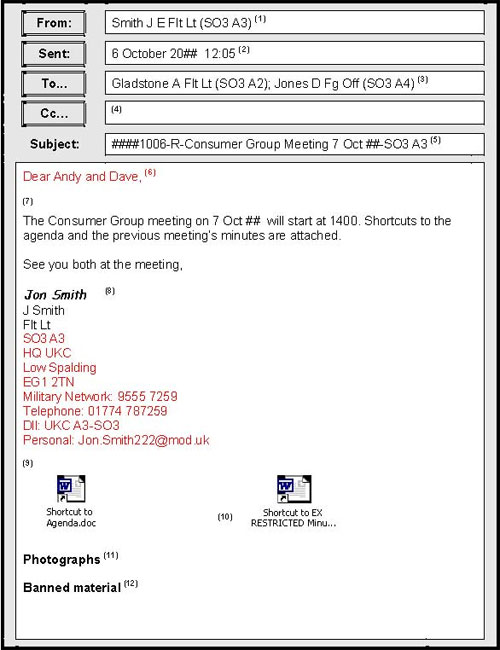- Email is an easy and quick way of corresponding.It also tends to have an informal style. All this brings many benefits but also presents problems. Email can easily be forwarded, which quickly allows gossip or sensitive information to become public knowledge.
- Despite its informality, email has the same purpose and status as any other official document.Email may need to be filed (electronically or in hard copy) if, for example, it is the principal record of an instruction or decision. Email is also subject to FOI and Data Protection law and may have to be released for public scrutiny.
Best practice for using email
- There are several simple ways to make best use of email, and to help you meet the requirements of the FOI Act:
- To meet FOI requirements, we must be able to carry out searches for requested material. b. Set realistic priorities on your outgoing email. People get fed up with opening high importance email, only to find routine material.
- Be concise and clear:
- External email. If you send email to people outside your immediate work area, do not use acronyms, abbreviations or jargon. Avoid being too brief or informal, as you may offend or be misunderstood.
- Internal email. If your email is only for people who work in your immediate area, you may use note-form English, or some acronyms or jargon. But never let clarity suffer in the quest for brevity.
- Do not use Internet-type email jargon or text-message style, and do not overuse capitals, bold font or underlining.
- An informal reply to email may be acceptable, but it is still an official departmental view. An incorrect or incomplete reply could have legal or other implications.
- Always use an email signature block, so recipients know who you are, especially if you are working from a group mailbox. Do not use a facsimile signature.It increases the size of the email, and some people may not be able to read it or might copy it to another document.
- In a reply email, only keep original text when it is essential, or when your reply includes someone who did not see the original.And don't expect an immediate reply to your email. If you need an urgent reply, use a priority flag. If necessary, follow up the email with a telephone call.
- Remember that large attachments (including documents containing badge or crest images) increase email size. If recipients have access to a common file storage area, use hyperlinks or shortcuts rather than attaching files. This reduces the size of the email and does not slow up the network. Only attach documents when recipients do not have common access to files.
- Don't assume that because you sent an attached document it has been read. Large documents take time to read, even if you can attach and send them effortlessly.
- Don't send a hard copy document as well as the email.This defeats the purpose of using email.
- Don't use a large email distribution list as a catch-all device.Consider which people need the information. Modify large distribution lists whenever possible.
Notes about email
Send only UNCLASSIFIED email via the Internet:
- From. Originator’s email address entered automatically when message transmitted.
- Sent. Date and time entered automatically when email sent.
- To. The action addressees. Use distribution or contact lists if appropriate. Always consider if all addressees need to receive the email.
- Cc. Abbreviation for ‘carbon copy’ and is the box where information addressees are entered.
- Do not send Cc email to people ‘just in case’ – especially to superiors. Use distribution or contact lists if appropriate.
- Do not use Bcc (‘blind carbon copy’). If you add a recipient's name to Bcc box, a copy of the message is sent to that recipient, but that name not visible to any other recipient of the message.
- Subject line. Use abbreviations to restrict the number of characters displayed. Include the following information:
a.Date format: yyyymmdd.
b.The highest PM that applies to the body of the message or any attachment: P for protect; R for restricted; C for confidential; S for secret; TS for top secret.Also show any descriptor
c.The subject of the email; keep it brief, but ensure it reflects the subject.
d.The job title of the sender.
- Greeting. May be informal, using first names for equals or juniors; use rank (non-military use Mr, Mrs, Ms or Miss) and surname for superiors. Test is not just how well recipients are known, but who might also see email.
- Content.
a.Cover one subject area only to help filing or archiving.
b.Always be accurate, brief and clear. Write in clear, properly structured English.Or use note-form to MOD recipients, so long as the meaning is clear. Do not use text-message style.
c.Style and tone appropriate for rank or grade of recipient(s). Remember, ‘divert’ facilities might be in use and message re-routed to unexpected recipient.
- Signature block. Set up a signature block in MS Outlook (select Tools, Options, Mail Format, Signatures, Create Signature) and then set the signature to appear automatically in new messages, replies or forwards. Include your name, rank, job title, address, full-figure military and civilian telephone numbers and personal email addresses.
- Attachments. Large attachments sent over networks slow down transfer rates:
a.Try not to attach more than one file; use WinZip to reduce file size.
b.When possible, be sure that recipients have application(s) needed to open or view attachments.
- Shortcuts. When recipients have access to common file storage area (network drive), attach shortcut or hyperlink to file, not the file itself.
- Photographs. Send only when no other way to meet deadline. Must be in JPEG (.jpeg or .jpg) or TIFF format.
- Banned material. Never send gossip, abusive, discriminatory, pornographic or offensive material.
Download
Download this document and example as a file (.doc 126kb)
